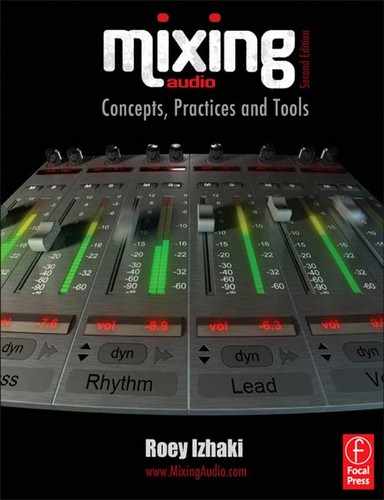Book Description
Your mix can make or break a record, and mixing is an essential catalyst for a record deal. Professional engineers with exceptional mixing skills can earn vast amounts of money and find that they are in demand by the biggest acts.
To develop such skills, you need to master both the art and science of mixing. The new edition of this bestselling book offers all you need to know and put into practice in order to improve your mixes. Covering the entire process --from fundamental concepts to advanced techniques -- and offering a multitude of audio samples, tips and tricks, this book has it all.
Roey Izhaki teaches you the importance of a mixing vision, how to craft and evaluate your mix and then take it a step further. He describes the theory and the tools used and how these are put into practice while creating mixes.
Packed full of photos, graphs, diagrams and audio samples, Mixing Audio is a vital read for anyone wanting to succeed in the field of mixing.
New to this edition:
* Multitracks provided to help practice mixing
* Fully updated with current plug-in and software version and information
* Companion website with a multitude of new samples including more macro-mixing samples
* A new sample mix: Rock n' Roll
Table of Contents
- Acknowledgments
- Introduction
- Symbols and formats used
- Part I Concepts and Practices
- 1 Music and mixing
- Music – An extremely short introduction
- The role and importance of the mix
- The perfect mix
- Further reading
- 2 Some axioms and other gems
- Louder is perceived as better
- Percussives weigh less
- Importance
- Natural vs. artificial
- Change
- 3 Learning to mix
- What makes a great mixing engineer?
- Methods of learning
- Mixing analysis
- Reference tracks
- 4 The process of mixing
- Mixing and the production chain
- The mix as a composite
- Where to start
- Deadlocks
- Milestones
- Finalizing and stabilizing the mix
- 5 Related issues
- How long does it take?
- Breaks
- Using solos
- Mono listening
- Housekeeping
- Mix edits
- Mastering
- Further reading
- 6 Mixing domains and objectives
- Mixing objectives
- Frequency domain
- Level domain
- Stereo domain
- Depth
- Part II Tools
- 7 Monitoring
- How did we get here?
- Choosing monitors
- The room factor
- Positioning monitors
- Headphone mixing
- Further reading
- 8 Meters
- Amplitude vs. level
- Mechanical and bar meters
- Peak meters
- Average meters
- Phase meters
- 9 Mixing consoles
- Buses
- Processors vs. effects
- Basic signal flow
- The importance of signal flow diagrams
- Groups
- In-line consoles
- The monitor section
- Solos
- Correct gain structure
- The digital console
- 10 Software mixers
- Tracks and mixer strips
- Routing
- The internal architecture
- 11 Phase
- What is phase?
- Problems
- Tricks
- 12 Faders
- Types
- Scales
- Working with faders
- 13 Panning
- How stereo works
- Pan controls
- Types of track
- Panning techniques
- Beyond pan pots
- Further reading
- 14 Equalizers
- Applications
- The frequency spectrum
- Types and controls
- Graphic equalizers
- In practice
- Equalizing various instruments
- 15 Introduction to dynamic range processors
- Dynamic range
- Dynamics
- Dynamic range processors in a nutshell
- 16 Compressors
- The course of history
- The sound of compressors
- Principle of operation and core controls
- Additional controls
- Controls in practice
- Applications
- Tricks
- More on compressors
- 17 Limiters
- 18 Gates
- Controls
- Applications
- In practice
- Tricks
- 19 Expanders
- Controls
- In practice
- Upward expanders
- 20 Duckers
- Operation and controls
- Applications
- 21 Delays
- Delay basics
- Types
- In practice
- Applications
- 22 Other modulation tools
- Vibrato
- ADT
- Chorus
- Flanging
- Phasing
- Tremolo
- 23 Reverbs
- What is reverb?
- Applications
- Types
- Reverb programs
- Reverb properties and parameters
- Early reflections (ERs)
- Reverbs and stereo
- Other reverb types
- Reverbs in practice
- 24 Distortion
- Background
- Distortion basics
- Ways to generate distortion
- 25 Drum triggering
- Methods of drum triggering
- 26 Other tools
- MS
- Pitch shifters and harmonizers
- Exciters and enhancers
- Transient designers
- 27 Automation
- Automation engines
- The automation process
- Automation alternatives
- Control surfaces
- Part III Simple Mixes
- 28 Show Me (Rock n’ Roll)
- Drums
- Bass
- Rhythm guitar
- Lead
- Vocal
- 29 It's Temps Pt. II (Hip Hop/Urban/Grime)
- Beat
- Bass
- Bass support
- Other tracks
- Vocals
- 30 Donna Pomini (Techno)
- Ambiance reverb
- Beat
- Sound FX
- Bass
- Vocal
- Other elements
- 31 The Hustle (DnB)
- Ambiance reverb
- Drums
- Dirt Kick
- Motif elements
- Pads
- Horns and brass
- Risers
- Strings
- 32 Hero (Rock)
- Drums
- Bass
- Rhythm guitar
- Lead guitar
- Vocals
- Appendix A   The Science of Bouncing
- Appendix B   Notes to Frequencies Chart
- Appendix C   Delay Time Chart
- Index
